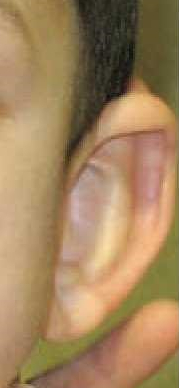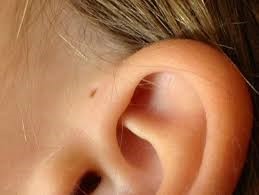Kabuki syndrome
2. Introduction to otorhinolaryngological problems in Kabuki syndrome
Morphology of the Auricles
The vast majority of children with SK experience some issues related to a part of the ear, ranging from abnormalities in the morphology of the outer ear to hearing problems.

Auricular Dimples
Auricular dimples are also relatively common and do not necessarily indicate associated hearing problems in all cases, but they should be ruled out.

Otitis media
This middle ear infection is the most common cause of hearing loss in children. It can affect one or both ears and occurs when pus and mucus accumulate behind the eardrum due to blockage of the Eustachian tube from allergies, colds, or other upper respiratory infections. If untreated, otitis media can lead to eardrum perforation, as well as hearing loss and infections of the mastoid bone located behind the ear.
From a medical perspective, chronic otitis media in children with SK is a significant cause of morbidity, including conductive hearing loss. However, it is unclear whether this finding is related to an underlying susceptibility to infection or to craniofacial anomalies, such as palatal insufficiency.
Hearing loss
Up to 50% of individuals with SK have hearing loss. Although chronic otitis media is the most common cause, sensorineural hearing loss can occur rarely, and some individuals may experience progressive hearing loss. Internal ear malformations have been reported, including Mondini dysplasia, vestibular enlargement, aplastic cochlea and semicircular canals, and enlarged aqueduct. At least one person with a clinical diagnosis of Kabuki syndrome who had progressive profound sensorineural hearing loss received a cochlear implant, with reported improvement in quality of life.